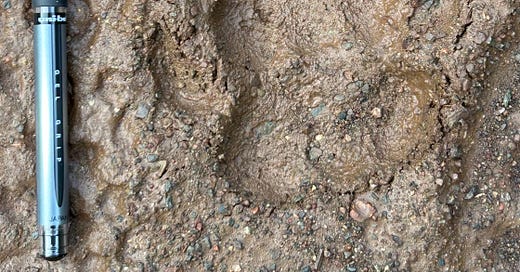The Unseen Beast Appears
An unusual paw print reminds me that legendary creatures beyond our ken prowl the woods nearby.
What drew me first to the track in the rain-softened fire road was its sheer size. No claw marks, which ruled out somebody’s Great Dane or St. Bernard. And there was something distinctly undoggy about its roundness, something feline perhaps. I’ve seen bobcats here, but this print was way too large to have been made by an animal that rarely tops 30 pounds.
As I took a photo with my pen laid alongside to register the print’s size, I wondered, “Could this be a cougar?” Was that too much to hope for?
Cougars — a.k.a. pumas, mountain lions, panthers, painters, catamounts — have inhabited Mt. Diablo as well as a long stretch of both North and South America for several million years. Even though the mountain sits at the greening edge of the San Francisco Bay metropolis, its 90,000 preserved acres plus adjoining ranch lands add up to a significant, connected wild space. Not wilderness by the definition in federal law, yet wild and open and beckoning to a wide range of critters from small to large, from amphibian and reptilian to avian and mammalian, from commonplace to rare, from stay-at-home to wide-ranging.
In some 40 years of regularly trekking around and about the mountain, I’ve seen most of the four-leggeds that frequent the area. Raccoons, possums, California ground squirrels, gray squirrels, mice, voles, gophers, shrews, bobcats, gray foxes, coyotes, bobcats, black-tailed deer. And wild pigs, those bristling, black, betusked descendants of domestic swine that went feral during the Mexican mission era then interbred with European wild boar imported and released by idiot big-game hunters. But no cougars, not so far anyway. Could I have just stumbled into concrete, close-up evidence of one such big cat?
Canids like dogs, coyotes, and foxes can’t retract their claws, so their tracks typically show those claws’ small prints, like little divots in front of the toes. Not so felines, which pull their claws in to keep them sharp and then unsheathe for attack. The big track I’d photographed showed no claw marks, which pointed to a cat. But the proof point that this track belonged to a cougar was the heel pad. A dog’s has one lobe on the leading surface and two smallish, almost indistinct lobes on the rear. A cougar print displays two prominent lobes on the leading surface and three on the rear. The overall effect is to make a cougar’s heel pad look something like a blown-up, bold-face, upper-case M.
A bobcat’s print is much the same, but smaller, on the order of 1.5 inches long. The track I photographed slightly exceeded 5 inches, making it far too large for even a big bobcat’s. That settled it. There I was in Mitchell Canyon beholding evidence of the recent presence of a majestic creature I have yet to lay eyes on. The rush of that realization is still running through me.
Given human arrogance, it is easy to assume that the creatures we do spot represent all the wild inhabitants of an open space. If it’s important, we’ve seen it or heard it or smelled it, or so we delude ourselves into thinking. The truth, though, is that much of what happens in the wild gets right past us.
For years now, Gayle and I have positioned wildlife cameras along game trails threading across our parcel of second-growth forest in the Trinity River mountains of far northern California. The accumulated cache of images and videos has been nothing short of a revelation. It contains, of course, abundant evidence of the creatures we know to be there, like gray foxes, gray squirrels, black-tailed deer, ravens, striped skunks, ringtails, deer mice, and black bears. But then there are the surprises, the unusual suspects we have yet to lay eyes on: flying squirrels, spotted skunks, fishers, northern pygmy owls, bobcats, Roosevelt elk, and, yes, cougars. Encountering the evidence of these unseen creatures widens the sense of what’s out there, of who the neighbors are.
Now when I walk the Mt. Diablo trails, I know that one big bruiser of a cougar is following these same pathways, hunting, looking for mates, keeping an eye out for the unwelcome and unwanted — which includes me, no doubt. He may be watching this very moment, only a few feet away, crouched and concealed, wanting me to be on my oblivious way. As I pass by, his wild gaze blesses me.






“No claw marks, which ruled out somebody’s Great Dane or St. Bernard.”
Beautiful essay! I love the quality of attention you bring to this encounter.